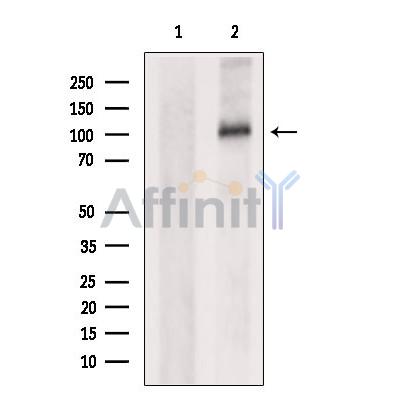OSMR Antibody - #DF12682
| Product: | OSMR Antibody |
| Catalog: | DF12682 |
| Description: | Rabbit polyclonal antibody to OSMR |
| Application: | WB |
| Reactivity: | Human, Mouse, Monkey |
| Prediction: | Pig, Sheep, Rabbit, Dog, Xenopus |
| Mol.Wt.: | 111 kDa; 111kD(Calculated). |
| Uniprot: | Q99650 |
| RRID: | AB_2845644 |
Related Downloads
Protocols
Product Info
*The optimal dilutions should be determined by the end user. For optimal experimental results, antibody reuse is not recommended.
*Tips:
WB: For western blot detection of denatured protein samples. IHC: For immunohistochemical detection of paraffin sections (IHC-p) or frozen sections (IHC-f) of tissue samples. IF/ICC: For immunofluorescence detection of cell samples. ELISA(peptide): For ELISA detection of antigenic peptide.
Cite Format: Affinity Biosciences Cat# DF12682, RRID:AB_2845644.
Fold/Unfold
IL-31 receptor subunit beta; IL-31R subunit beta; IL-31R-beta; IL-31RB; Interleukin-31 receptor subunit beta; MGC140467; MGC150626; MGC150627; MGC75127; Oncostatin M receptor; Oncostatin M specific receptor subunit beta; Oncostatin M-specific receptor, beta; Oncostatin-M-specific receptor subunit beta; Osmr; OSMR_HUMAN; OSMRB;
Immunogens
A synthesized peptide derived from human OSMR, corresponding to a region within the internal amino acids.
Expressed in keratinocytes (at protein level) (PubMed:21261663). Expressed at relatively high levels in all neural cells as well as fibroblast and epithelial cells (PubMed:8999038).
- Q99650 OSMR_HUMAN:
- Protein BLAST With
- NCBI/
- ExPASy/
- Uniprot
MALFAVFQTTFFLTLLSLRTYQSEVLAERLPLTPVSLKVSTNSTRQSLHLQWTVHNLPYHQELKMVFQIQISRIETSNVIWVGNYSTTVKWNQVLHWSWESELPLECATHFVRIKSLVDDAKFPEPNFWSNWSSWEEVSVQDSTGQDILFVFPKDKLVEEGTNVTICYVSRNIQNNVSCYLEGKQIHGEQLDPHVTAFNLNSVPFIRNKGTNIYCEASQGNVSEGMKGIVLFVSKVLEEPKDFSCETEDFKTLHCTWDPGTDTALGWSKQPSQSYTLFESFSGEKKLCTHKNWCNWQITQDSQETYNFTLIAENYLRKRSVNILFNLTHRVYLMNPFSVNFENVNATNAIMTWKVHSIRNNFTYLCQIELHGEGKMMQYNVSIKVNGEYFLSELEPATEYMARVRCADASHFWKWSEWSGQNFTTLEAAPSEAPDVWRIVSLEPGNHTVTLFWKPLSKLHANGKILFYNVVVENLDKPSSSELHSIPAPANSTKLILDRCSYQICVIANNSVGASPASVIVISADPENKEVEEERIAGTEGGFSLSWKPQPGDVIGYVVDWCDHTQDVLGDFQWKNVGPNTTSTVISTDAFRPGVRYDFRIYGLSTKRIACLLEKKTGYSQELAPSDNPHVLVDTLTSHSFTLSWKDYSTESQPGFIQGYHVYLKSKARQCHPRFEKAVLSDGSECCKYKIDNPEEKALIVDNLKPESFYEFFITPFTSAGEGPSATFTKVTTPDEHSSMLIHILLPMVFCVLLIMVMCYLKSQWIKETCYPDIPDPYKSSILSLIKFKENPHLIIMNVSDCIPDAIEVVSKPEGTKIQFLGTRKSLTETELTKPNYLYLLPTEKNHSGPGPCICFENLTYNQAASDSGSCGHVPVSPKAPSMLGLMTSPENVLKALEKNYMNSLGEIPAGETSLNYVSQLASPMFGDKDSLPTNPVEAPHCSEYKMQMAVSLRLALPPPTENSSLSSITLLDPGEHYC
Predictions
Score>80(red) has high confidence and is suggested to be used for WB detection. *The prediction model is mainly based on the alignment of immunogen sequences, the results are for reference only, not as the basis of quality assurance.
High(score>80) Medium(80>score>50) Low(score<50) No confidence
Research Backgrounds
Associates with IL31RA to form the IL31 receptor. Binds IL31 to activate STAT3 and possibly STAT1 and STAT5. Capable of transducing OSM-specific signaling events.
Membrane>Single-pass type I membrane protein.
Expressed in keratinocytes (at protein level). Expressed at relatively high levels in all neural cells as well as fibroblast and epithelial cells.
The WSXWS motif appears to be necessary for proper protein folding and thereby efficient intracellular transport and cell-surface receptor binding.
The box 1 motif is required for JAK interaction and/or activation.
Belongs to the type I cytokine receptor family. Type 2 subfamily.
Research Fields
· Environmental Information Processing > Signaling molecules and interaction > Cytokine-cytokine receptor interaction. (View pathway)
· Environmental Information Processing > Signal transduction > PI3K-Akt signaling pathway. (View pathway)
· Environmental Information Processing > Signal transduction > Jak-STAT signaling pathway. (View pathway)
Restrictive clause
Affinity Biosciences tests all products strictly. Citations are provided as a resource for additional applications that have not been validated by Affinity Biosciences. Please choose the appropriate format for each application and consult Materials and Methods sections for additional details about the use of any product in these publications.
For Research Use Only.
Not for use in diagnostic or therapeutic procedures. Not for resale. Not for distribution without written consent. Affinity Biosciences will not be held responsible for patent infringement or other violations that may occur with the use of our products. Affinity Biosciences, Affinity Biosciences Logo and all other trademarks are the property of Affinity Biosciences LTD.

